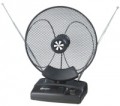Signal reception
Types of broadcasting for which the antenna is designed. Different types of broadcasting differ in the frequencies used and signal characteristics, which requires appropriate features in the antennas.
—
Analogue TV. Classic terrestrial broadcasting in analogue format. Due to the low quality of the signal and the tendency to interference, today it is considered completely obsolete, it is found mainly in those regions where DVB-T/T2 (see below) digital broadcasting has not yet been deployed. However, the requirements for antennas for analogue television broadcasting are no different from those for "digital" ones; therefore, almost all modern models, even those originally created for DVB-T/T2, work with an analogue signal without any problems.
—
DVB-T/T2. Digital terrestrial television, which replaced the analogue described above. Its main advantages are the ability to work with HD formats, as well as the fact that the quality does not depend on the signal level: either the viewer receives a full-fledged "picture" and sound, or they disappear completely (with a critical decrease in the signal level). Technically, DVB-T and DVB-T2 are different standards that are not compatible with each other; however, they have the same antenna requirements, so in this case, both types of broadcasting can be described together.
—
FM radio. The FM range (more
...precisely, the standard) is very popular among music radio stations due to the high quality of the transmitted sound, including stereo capabilities. FM broadcasting is carried out in the range of 87.5 – 108 MHz, which is not used in television broadcasting; therefore, for devices with FM tuners (TVs can also be equipped with such receivers), you should choose antennas in which compatibility with this range is directly stated.VHF frequency range
The frequencies in the VHF range for which the antenna is designed. VHF includes frequencies from 30 to 300 MHz antennas with full coverage of this range are quite rare, but this is not required, because TV broadcast frequencies occupy only a part of VHF, and this part usually overlaps quite well.
Antenna sellers generally choose to sell models that are compatible with local frequencies. Therefore, in general, the frequency range is a rather specific parameter that the average user rarely needs — except when buying an antenna in another country. Also note that FM broadcasting in Europe and America uses the 87.5 – 108 MHz range, and antennas for such broadcasting (see "Signal Reception"), by definition, must cover these frequencies.
Output impedance
The internal resistance of the antenna to alternating current. The standard value for modern TV antennas is 75 ohms; it is this impedance that the connecting cable used to connect the antenna to the receiver should have — otherwise there can be no question of normal use.
Gain control
The ability
to control the built-in amplifier allows to stabilize the wave impedance between the antenna cable and the receiver. This prevents overloading, which in turn affects signal quality. Often, television antennas with a gain control option are equipped with their own 12 V power supply.
Cable length
The length of the connecting cable supplied with the antenna (often non-detachable). Quite a lot of models come with a cable right away, which eliminates the need to purchase it separately. And knowing the length of the cable, you can evaluate whether it is enough to reach the TV without additional cables.

